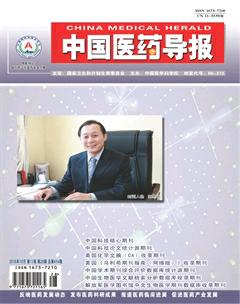自发性孤立性肠系膜上动脉夹层的血管内支架治疗
沈涛 黄优华 石红建 徐强 宋蒨 徐元丰
[摘要] 目的 探讨血管内支架治疗自发性孤立性肠系膜上动脉夹层(SISMAD)的价值。 方法 回顾性分析2008年1月~2014年11月江苏大学附属武进人民医院收治并行血管内支架治疗的10例SISMAD患者的临床资料及随访结果,参照Sakamoto血管影像学分型,Ⅱ型4例,Ⅲ型6例,探讨血管内支架治疗SISMAD的可行性和效果。 结果 10例患者均成功植入血管内支架;术后10例患者腹痛症状均缓解;1例患者出现肠系膜上动脉远端分支破裂出血,予不锈钢圈栓塞,余无严重并发症。随访6~36个月,平均26个月,患者无再发腹痛症状,增强CT显示所有患者肠系膜上动脉支架内血流通畅,夹层愈合。 结论 血管内支架治疗Ⅱ、Ⅲ型SISMAD是一种有效、安全的方法。
[关键词] 肠系膜上动脉;夹层;孤立性;支架
[中图分类号] R657.2 [文献标识码] A [文章编号] 1673-7210(2016)10(a)-0052-04
Endovascular stent placement for spontaneous isolated superior mesenteric artery dissection
SHEN Tao HUANG Youhua SHI Hongjian XU Qiang SONG Qian XU Yuanfen
Department of Vascular and Interventional Radiology, Wujin People's Hospital Affiliated to Jiangsu University, Jiangsu Province, Changzhou 213002, China
[Abstract] Objective To discuss the value of endovascular stent placement for spontaneous isolated superior mesenteric artery dissection (SISMAD). Methods The clinical data of 10 patients with SISMAD, who were admitted to Wujin People's Hospital Affiliated to Jiangsu University to receive endovascular stent placement during the period from January 2008 to November 2014, were retrospectively analyzed. According to Sakamoto angiographic categorization, 4 cases were classified as type Ⅱ and 6 cases were classified as type Ⅲ. The feasibility and efficacy of endovascular stent for SISMAD were evaluated. Results All 10 patients underwent successfully endovascular stent placement, and all of them got a release of abdominal pain after operation. One patient's distal branch of superior mesenteric artery (SMA) was ruptured with bleeding, and was cured with coil embolization. No other serious complications occurred. All patients were followed-up for 6-36 months, average of 26 months, no recurrence of abdominal pain. Enhanced CT examination showed complete resolution of the dissection and all stent in SMA patent. Conclusion Endovascular treatment is an effective and feasible therapeutic approach for type Ⅱ and Ⅲ of SISMAD.
[Key words] Superior mesenteric artery; Dissection; Isolated; Stent
自发性孤立性肠系膜上动脉夹层(spontaneous isolated superior mesenteric artery dissection,SISMAD)曾被认为是一种临床罕见的疾病,随着多层螺旋CT血管成像(MSCTA)及MR血管成像(MRA)的广泛应用,近年来,国内关于SISMAD的报道明显增加[1-2]。但是SISMAD病因尚不清楚,至今仍然没有统一的治疗规范[3-6]。江苏大学附属武进人民医院(以下简称“我院”)2008年1月~2014年11月通过植入血管内支架成功治疗了10例SISMAD患者,现总结分析如下:
1 资料与方法
1.1 一般资料
1.1.1 临床资料
收集我院10例SISMAD患者,其中,男9例,女1例,年龄42~62岁,平均57岁。10例患者中,5例有高血压病史,2例有常年吸烟史。
1.1.2 临床表现
10例患者均为突发的持续性上腹部或中腹部疼痛,1例疼痛向背部放射,3例有恶心、呕吐。10例患者均无腹膜刺激症状及低血容量休克征象。
1.1.3 影像学检查
10例患者均通过主动脉CTA及血管造影检查明确诊断,符合以下表现者即可诊断为SISMAD[7]:①肠系膜上动脉(SMA)内可见内膜片形成;②SMA内可见双腔结构,双腔内见对比剂填充;③SMA壁内可见半月形结构,可有溃疡形结构(ulcer like projection,ULP)与动脉腔相通。同时,主动脉及其他内脏动脉无夹层的病变表现。参照Sakamoto[4]影像学分型进行分型,见图1。本组10例患者中4例为Ⅱ型,6例为Ⅲ型。
I型:假腔有近、远端破口,假腔内血流通畅;Ⅱ型:假腔有近端破口,无远端破口;Ⅲ型:假腔内血栓形成,并可见溃疡样龛影由真腔突入假腔;Ⅳ型:假腔完全性血栓形成,动脉壁上无溃疡样破口
图1 Sakamoto影像学分型示意图
1.2 方法
1.2.1 治疗方法
1.2.1.1 术前准备 本组10例患者确诊为SISMAD后,即予以禁食、控制血压、抗凝、抗血小板及营养支持等治疗。
1.2.1.2 手术方法 在数字减影血管造影(digital subtraction angiography,DSA)下,采用改良Seldinger技术穿刺一侧股动脉或左肱动脉,置入5F导管鞘,经鞘送入5F猪尾巴导管至腹主动脉上段行正位和侧位造影,了解SMA夹层病变区域情况。全身肝素化,交换置入8F导管鞘,在侧位工作角度下利用“同轴导管技术”送入8F导引导管、5F Cobra导管至SMA口部,黑泥鳅导丝、5F Cobra导管配合通过病变段真腔直至SMA远端,交换超硬交换导丝,沿导丝交换送入血管内支架及释放系统,准确定位后释放血管内支架覆盖夹层破口处。
1.2.2 术后处理及随访
术后常规抗血小板治疗(拜阿司匹林100 mg/d,长期口服;氯吡格雷75 mg/d,口服3~6个月)。术后密切观察患者临床症状缓解情况,腹痛缓解后可逐步恢复饮食,从流质饮食过渡至普通饮食。术后第1、3、6、12、24、36个月随访,随访内容包括腹部症状、体征及CTA检查等,评估疗效。
2 结果
本组10例患者均成功植入血管内支架,手术成功率100%。1例患者植入血管内支架后造影见SMA远端分支破裂出血,超选择插管到位后予不锈钢圈栓塞;2例患者植入血管内支架后复查造影见支架远端SMA痉挛伴血栓形成,经导管内灌注罂粟碱30 mg,后留置导管,予罂粟碱30 mg、尿激酶25万U持续泵入,q24h,及抗凝治疗(低分子肝素钠0.4 mL,皮下注射,q12h),分别于2、3 d后复查造影见SMA主干及远端分支血流通畅、血栓溶解后拔管。10例患者出院前腹痛症状均逐渐消失,恢复正常饮食。术后随访6~36个月,平均26个月,患者无再发腹痛症状,增强CT显示所有患者SMA支架内血流通畅,夹层愈合。见图2。
A、B:CT增强横断位显示真腔狭窄,假腔内有血栓;C:CT冠状位重建显示夹层真假腔特征;D:VR显示夹层真假腔特征;E:DSA显示夹层真假腔特征与CTA一致;F:内支架植入后即刻造影示夹层假腔不显影,真腔主干及远端血流恢复;G:术后3个月CTA示夹层修复,支架内血流通畅
图2 SISMAD Ⅲ型患者相关影像学资料
3 讨论
SISMAD是一种临床较少见的疾病,1947年Bauersfeld[8]首次对该疾病进行了描述,近几年随着CTA、MRA等的广泛应用,该疾病确诊越来越多。SISMAD的病因尚不清楚,可能的病因包括男性、高血压、动脉硬化、动脉中膜囊性坏死、肌纤维发育不良、结缔组织病、血管炎、肿瘤、创伤、怀孕等[9-11]。Solis等[12]发现,SISMAD的第一破口通常位于距离肠系膜上动脉开口1.5~3 cm处,此处肠系膜上动脉由固定段移行为活动段,且此处为肠系膜上动脉走形的一个弓背点,故其受到的血流冲击力很大,动脉内膜容易撕裂,从而形成夹层。
SISMAD的主要症状为突发的上腹部剧痛,有时可累及腰背部,腹痛范围多集中在上腹和脐周,通常会伴有恶心、呕吐及腹泻症状,严重者可有肠缺血坏死或夹层动脉瘤破裂引起失血性休克而危及生命。大多数学者认为病情的转归与该疾病的分型密切相关。
目前主要有Sakamoto等[13]和Yun等[14]对SISMAD进行了影像学分型,目前被引用较多的是Sakamoto 4型分法。影像分型的目的在于指导制订治疗策略。Ⅰ型破裂的风险低,可采取保守治疗和定期复查;Ⅱ、Ⅲ型因夹层可能进一步扩大导致真腔狭窄甚至闭塞,或夹层持续增大而形成假性动脉瘤导致破裂大出血,因此这两种类型建议采取手术或介入治疗;Ⅳ型如果真腔的血流通畅,可采取保守治疗和定期复查,若假腔扩大影响真腔血流,则应采取积极手术或介入治疗[15-16]。本组10例患者中4例为Ⅱ型,6例为Ⅲ型,均采取植入血管内支架进行治疗。
目前有多篇文献报道了植入血管内支架治疗SISMAD以及随访取得了良好效果[14-17]。本组10例患者经术后6~36个月的影像学及临床随访,结果令人满意,患者无再发腹痛症状,增强CT显示所有患者SMA支架内血流通畅,夹层愈合,达到治愈效果。
血管内支架植入治疗Ⅱ、Ⅲ型SISMAD的机制:植入血管内支架可以恢复SMA真腔的血流通畅;固定撕裂的血管内膜,防止夹层的进一步扩大;支架的“栅栏效应”可对动脉血管内皮的生长起到“内衬”作用,从而修复和重建病变段动脉血管壁,同时改变瘤腔内血流动力学,促进动脉瘤内血栓形成[18-19]。
支架类型的选择:文献中绝大多数学者选择自膨式裸支架[20],本组10例患者均采用了自膨式裸支架。自膨式裸支架柔顺性好,可适应有生理弯曲的SMA解剖,其径向支撑力足以恢复SMA的腔内形态。球扩式支架长度较短,且支架会随着球囊扩张而变僵直,不利于恢复原有SMA结构,还会造成病变处新损伤。覆膜支架不推荐常规使用,因其有可能封闭SMA近端的分支,导致肠道缺血,但在裸支架无效或已形成假性动脉瘤时可应用。支架长度的选择:支架长度不宜太长,只要支架能覆盖近端破口。如果支架长度过长,则支架和远端SMA的直径相差较大,易引起血管痉挛。如果确实需要选择长度较长的,可考虑选用锥形支架。支架直径:大于正常动脉直径10%即可[21]。
综上所述,影像学分型有助于SISMAD治疗方案的制订,血管内支架植入治疗Ⅱ、Ⅲ型SISMAD可使患者腹痛症状消失,SMA血流通畅,夹层愈合,且具有微创、安全等特点,值得临床推广应用。
[参考文献]
[1] Chang CF,Lai HC,Yao HY,et al. True lumen stenting for a spontaneously dissected superior mesenteric artery may compromise major intestinal branches and aggravate bowel ischemia [J]. Vasc Endovascular Surg,2014,48(1):83-85.
[2] Li N,Lu QS,Zhou J,et al. Endovascular stent placement for treatment of spontaneous isolated dissection of the superior mesenteric artery [J]. Ann Vasc Surg,2014,28(2):445-451
[3] Li DL,He YY,Alkalei AM,et al. Management strategy for spontaneous isolated dissection of the superior mesenteric artery based on morphologic classification [J]. J Vasc Surg,2014,59(1):165-172.
[4] Luan JY,Guan X,Li X,et al. Isolated superior mesenteric artery dissection in China [J]. J Vasc Surg,2016,63(2):530-536.
[5] Chu SY,Hsu MY,Chen CM,et al. Endovascular repair of spontaneous isolated dissection of the superior mesenteric artery [J]. Clin Radiol,2012,67(1):32-37.
[6] Zerbib P,Perot C,Lambert M,et al. Management of isolated spontaneous dissection of superior mesenteric artery [J]. Langenbecks Arch Surg,2010,395(4):437-443.
[7] Subhas G,Gupta A,Nawalany M,et al. Spontaneous isolated superior mesenteric artery dissection:a case report and literature review with management algorithm [J]. Ann Vasc Surg,2009,23(6):788-798.
[8] Bauersfeld SR. Dissection aneurysm of the aorta:a presentation of fifteen and a review of the literature [J]. Ann Intern Med,1947,26(1):873.
[9] D'Ambrosio N,Friedman B,Siegel D,et al. Spontaneous isolated dissection of the celiac artery:CT findings in adults [J]. AJR,2007,188(6):W506-511.
[10] Park YJ,Park KB,Kim DI,et al. Natural history of sponta neous isolated superior mesenteric artery dissection derived from follow-up after conservative treatment [J]. J Vasc Surg,2011,54(6):1727-1733.
[11] Kim HK,Jung HK,Cho J,et al. Clinical and radiologic course of symptomatic spontaneous isolated dissection of the superior mesenteric artery treated with conservative management [J]. J Vasc Surg,2014,59(2):465-472
[12] Solis MM,Ranval TJ,McFarland DR,et al. Surgical treatment of superior mesenteric artery dissecting aneurysm and simultaneous celiac artery compression [J]. Ann Vasc Surg,1993,7(5):457-462.
[13] Sakamoto I,Ogawa Y,Sueyoshi E,et al. Imaging appearances and management of isolated spontaneous dissection of the superior mesenteric artery [J]. Eur J Radiol,2007, 64(1):103-110.
[14] Yun WS,Kim YW,Park KB,et al. Clinical and angiographic follow-up of spontaneous isolated superior mesenteric artery dissection [J]. Eur J Vasc Endovasc Surg,2009,37(5):572-577.
[15] Subhas G,Gupta A,Nawalany M,et al. Spontaneous isolated superior mesenteric artery dissection: a case report and literature review with management algorithm [J]. Ann Vasc Surg,2009,23(6):788-798.
[16] Ichiro S,Ogawa Y,Sueyoshi E,et al. Imaging appearances and management of isolated spontaneous dissection of the superior mesenteric artery [J]. Eur J Radiol,2007,64(1):103-110.
[17] Wu XM,Wang TD,Chen MF. Percutaneous endovascular treatment for isolated spontaneous superior mesenteric artery dissection:report of two cases and literature review [J]. Catheter Cardiovasc Interv,2009,73(2):145-151.
[18] Lovblad KO,Yilmaz H,Chouiter A,et al. Intracranial aneurysm stenting: follow-up with Mr angiography [J]. J Magn Reson Imaging,2006,24(2):418-422.
[19] Zenteno MA,Santos-Franco JA,Freitas-Modenesi JM,et al. Use of the sole stenting technique for the management of aneurysms in the posterior circulation in a prospective series of 20 patients [J]. J Neurosurg,2008,108(6):1104-1118.
[20] Leung DA,Schneider E,Kubik-Huch R,et al. Acute mesenteric ischemia caused by spontaneous isolated dissection of the superior mesenteric artery: treatment by percutaneous stent placement [J]. Eur Radiol,2000,10(12):1916-1919.
[21] Pang PF,Jiang ZB,Huang MS,et al. Value of endovascular stent placement for symptomatic spontaneous isolated superior mesenteric artery dissection [J]. Eur J Radiol,2013, 82(3):490-496.
(收稿日期:2016-06-29 本文编辑:程 铭)

